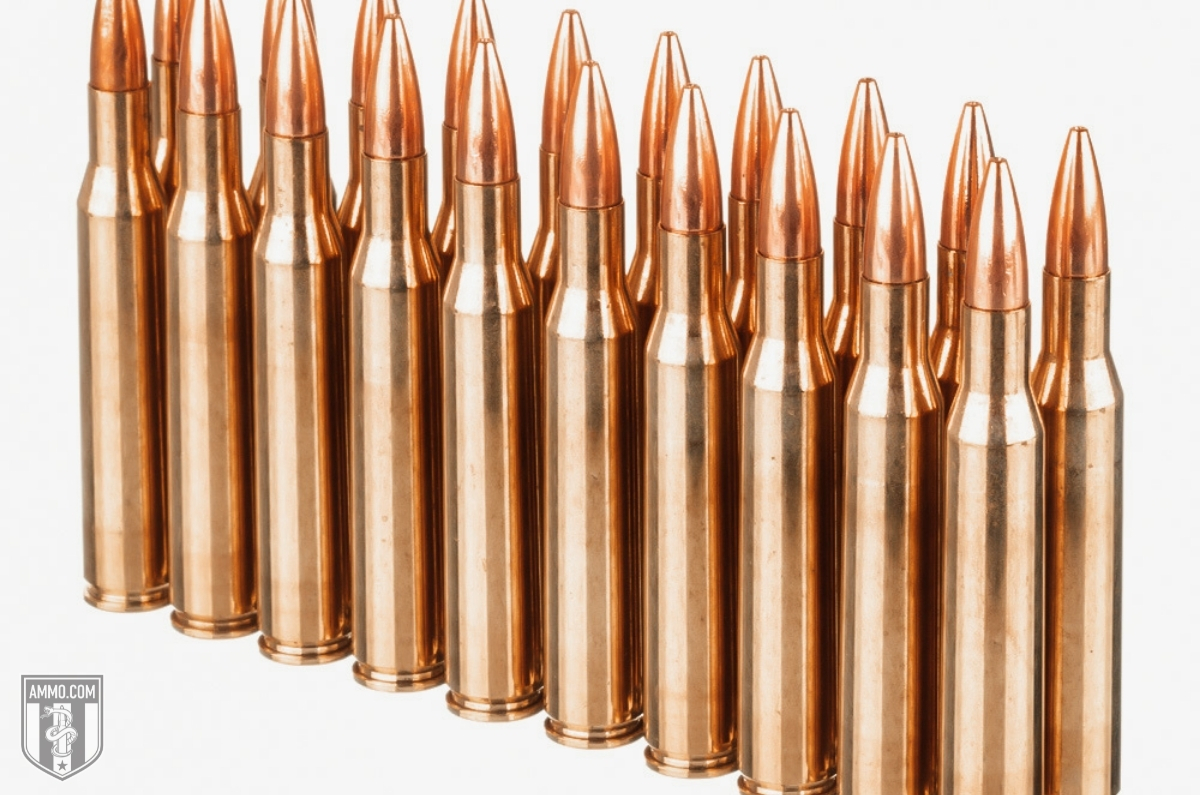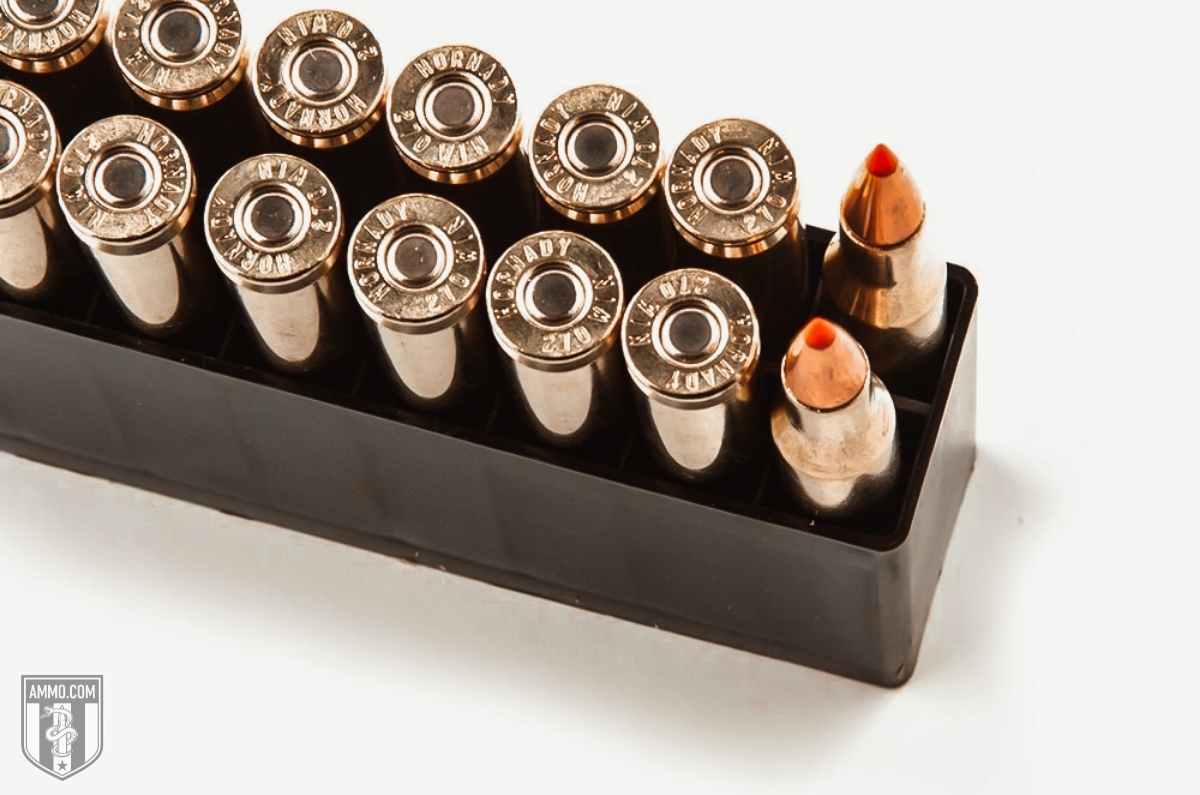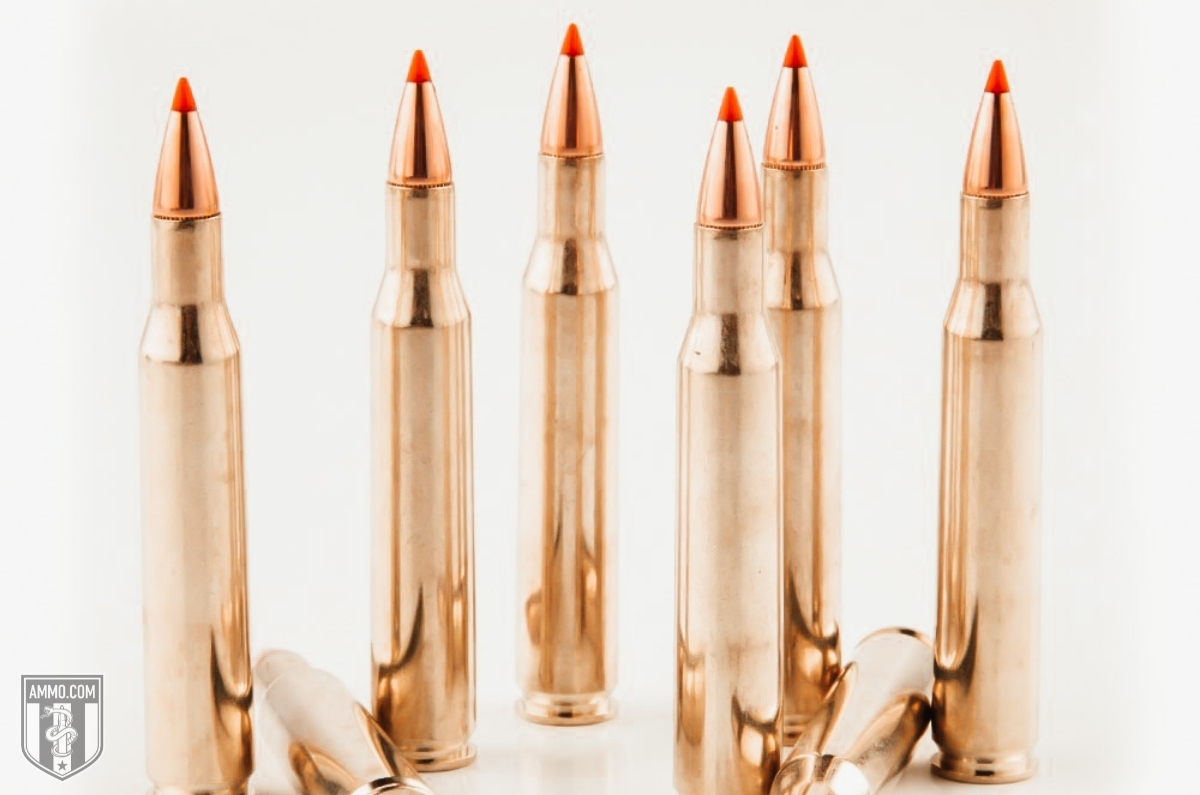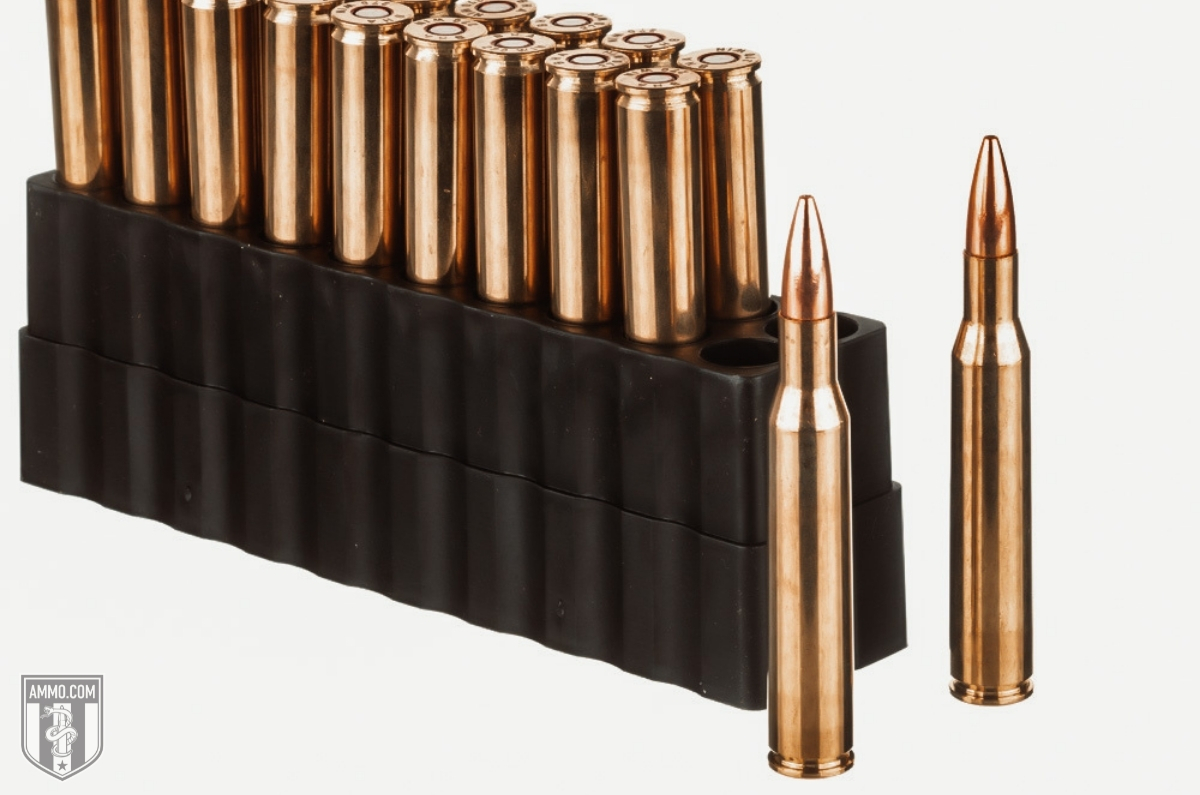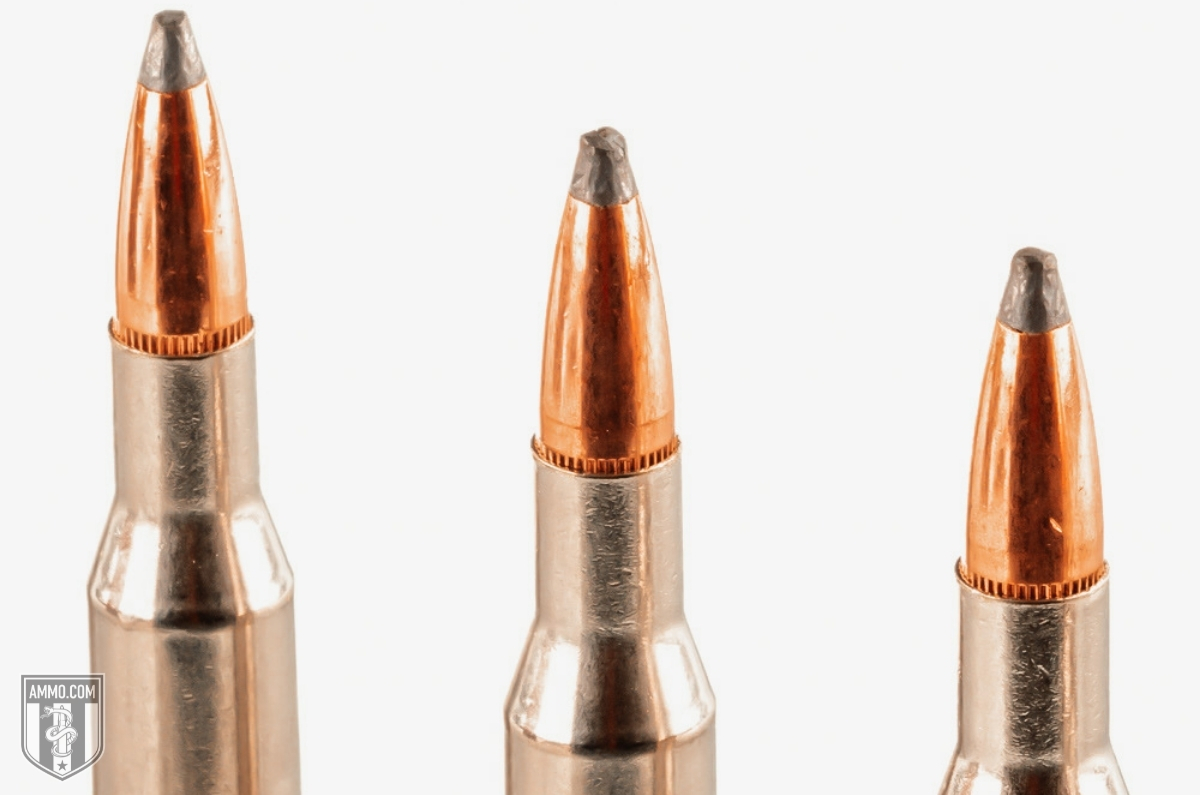270 vs 308: The Best Deer Hunting Caliber Duel
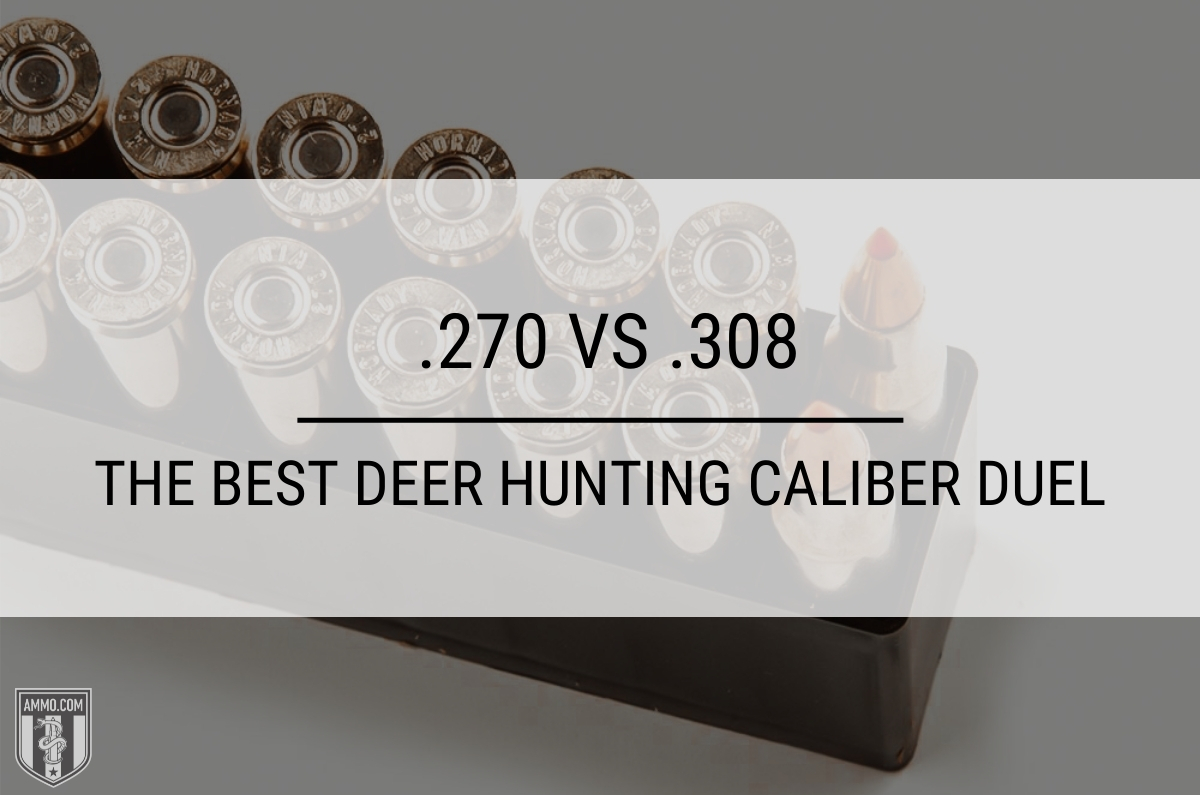 When it comes to the debate about what the best big game hunting cartridge is, the 270 Winchester and 308 Winchester are always in the middle of the discussion. Both the 270 Win and the 308 Win offer exceptional long range ballistic performance and have claimed countless game animals across North America and the world for decades.
When it comes to the debate about what the best big game hunting cartridge is, the 270 Winchester and 308 Winchester are always in the middle of the discussion. Both the 270 Win and the 308 Win offer exceptional long range ballistic performance and have claimed countless game animals across North America and the world for decades.
These spectacular hunting rounds have a track record about a mile long, but which one is going to be better for bagging that trophy whitetail, mule deer, or pronghorn antelope this hunting season?
In this caliber comparison we are going to break down the history, ballistics, and pros/cons of each cartridge to help you understand whether you should purchase a 308 Win or a 270 Win for your new hunting rifle.
Get your camos ready, your scent eliminator spray primed, and your hiking boots cleaned because we are about to head into the woods for this hunting caliber duel!
What is .270 Winchester? The History and Development of an All-Star Hunting Cartridge
As with many cartridges in the 20th Century, the 270 Winchester got its roots from the 30-06 Springfield. After the Spanish-American War, the United States Military began the process of creating a new cartridge after seeing the deadly efficiency of the 7x57mm Mauser round in the hands of Spanish troops. The round that was eventually selected is the lauded 30-06 Springfield which also came with the Army’s new bolt action rifle, the 1903 Springfield. The 30-06 Springfield was designed to fire 150gr bullets at 2,700 fps (feet per second).
The 30-06 was wildly successful and led to wildcatters using the 30-06 as a parent case to make new cartridges. A wildcatter is someone who makes their own custom cartridges that are not commercially available to achieve a specific purpose. Many wildcatters live true to my personal motto “go big or stay home," and necked up the 30-06 to accept a larger caliber bullet. Two wildcat cartridges that eventually became commercially available were the .35 Whelen and the .400 Whelen.
Winchester decided to take a page out of the Mauser Playbook and necked down the cartridge to accept a smaller diameter bullet that would be fired at a faster muzzle velocity. The .270 Win was introduced in 1925 and is a necked down version of the 30-03, the progenitor of the 30-06, to accept a 0.277” diameter bullet.
The original offering of the 270 Winchester came in their Model 54 bolt action rifle and was designed to fire 130 grain bullets at a muzzle velocity of 3,140 fps. The decision to use a 0.277” diameter bullet was a somewhat perplexing decision by Winchester as 270 was a relatively obscure caliber at the time. By comparison, the commonly known 7x57mm Mauser round fired a 0.284” diameter bullet. This decision by Winchester meant that the 270 Win was not an immediate commercial powerhouse like the 30-06 and the 270 Win lived in relative obscurity for many years.
Even today there are only a few cartridges that utilize the 0.277” in diameter bullet, the most popular being the 270 Winchester Short Magnum (270 WSM), the 270 Weatherby Magnum, and the 6.8 Remington SPC. It wasn’t until after WWII that Jack O’Connor began to expound upon his unabashed love affair with the 270 Winchester in Outdoor Life magazine. It was then that the popularity of the 270 grew. O’Connor had been using the 270 Win in many of his big game hunts and his articles are what is primarily credited with the rise in popularity of the cartridge.
Since then, the 270 Win has been steadily growing more and more in popularity due to its flatter trajectory, long range shooting capability, and versatility as a hunting round being able to ethically harvest game animals from groundhogs to elk. With the ability to shoot lighter bullets from 120gr for small game all the way up to a heavier bullet at 160gr for large game, the 270 Winchester allows you to have ammo versatility that other cartridges only dream about.
What is .308 Winchester? The 30-06 Slayer
After the Korean War, the US Military knew that they needed to up their game to keep up with the Soviet Union. They wanted a new battle rifle that was capable of both semi and fully automatic fire and featured a detachable magazine to keep pace with the AK-47. This meant that the 30-06 needed to go as it required a long action which is less suitable for fully automatic fire.
In 1952, Winchester released the 308 Win to the general shooting public. It was an immediate success and was the basis for the military adopting the 308 Winchester as the 7.62x51mm NATO with their new M14 service rifles in 1954. The 7.62 NATO round almost matched the 30-06 balletically and did so with a shorter cartridge case, meaning it would fit into a short action. The original load for the 7.62 NATO was capable of firing a 147 gr bullet at 2,750 fps, compared to 150gr bullets fired at 2,700 fps from the 30-06 Springfield.
The .308 and the M14 saw limited use in the Vietnam War before being replaced by the M16 and the 5.56x45mm NATO (223 Rem). Although the 308’s lifespan as our main rifle cartridge was short, it continued to see use in fully automatic machine guns like the M60 and was also utilized by sniper teams for long range shooting applications. Back on the civilian front, the 308 Winchester was a staple at NRA long range shooting matches, hunting lodges across North America, all the way to the African savannah. It truly is a workhorse of a cartridge that has been harvesting whitetail, elk, caribou, and even black bears for over half a century.
Although recently the 308 Win has fallen somewhat out of favor for newer rifle cartridges like the 300 Win Mag and the 6.5 Creedmoor, it is still an excellent choice for medium to large game hunting at longer range. The 308 Winchester is still utilized by numerous law enforcement agencies as its sniper ammo of choice, and who can blame them? The 308 has a proven track record and exceptional accuracy in both the backwoods and the battlefield.
The Comparison: 270 Winchester vs 308 Winchester
Now we come to the big question: which hunting round is going to be better for you?
When it comes to comparing the 308 Win to the 270 Win, we are on the verge of splitting hairs. Both of these cartridges are hunting stalwarts and excellent choices when it comes to your next hunting rifle. However, there are some differences that we will explore that might help you in this decision.
270 vs 308: Cartridge Specs
Let’s start off by taking a look at the cartridge dimensions and SAAMI specifications and see if we can spot any differences that stand out.
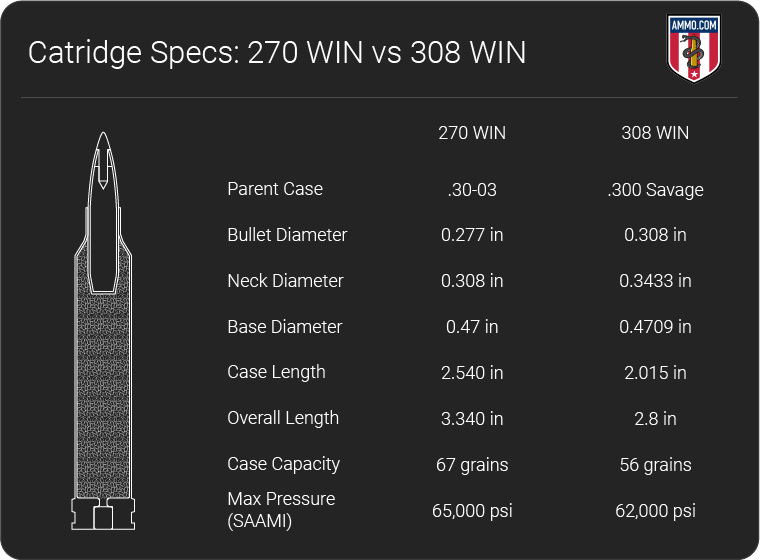
Right off the bat we see a massive difference in the case length of over ½ an inch. This is primarily due to what each cartridge was designed to do. The 270 Winchester is a necked down version of the 30-03 Springfield (the predecessor to the 30-06) to accept a 0.277” diameter bullet. The longer case means that the 270 Win will require a long action receiver whereas the 308 has a shorter case length and fits into a short action.
A short action requires less bolt throw to load another round. It is hypothetically possible that follow up shots will come faster from a 308 than a 270. However, in practice, there is no discernable difference between follow up shots on either platform. However, between the two there is a drastic difference in case capacity.
The 308 Winchester has a case capacity of 56 gr H20 where the 270 Win has almost 20% more case capacity, clocking in at 67 gr H20. This increased case capacity means larger powder charges can be used. This means that the more aerodynamic, lighter bullets coming out of the 270 are going to have a lot more velocity than their 308 counterparts. This increased muzzle velocity is one of the reasons why the 270 has a flatter trajectory, similar to the 6.5 Creedmoor and 300 Win Mag.
For more ammo options, don't foget to check out our Remington .270 Ammunition page.
But does that increased case capacity (and 3000 psi higher max pressure) come at a price when it comes to recoil? Let’s take a look!
270 vs 308: Recoil
Recoil is going to be an important factor for most shooters, as lower recoil will often translate to increase downrange accuracy. The less the rifle kicks your shoulder, the less likely you are to jerk the trigger and send your shot off target. This is why most youth shooters start with .22LR that has virtually no recoil: to develop solid trigger control fundamentals. Unless you are very new to shooting and have only been exposed to rimfire, the average shooter will describe the felt recoil of both cartridges as manageable and not overly offensive. That’s a nice way to say that you shouldn’t have a bruised shoulder after an hour at the range with either the 270 or the 308.
Felt recoil is a combination of multiple factors, including the rifle weight, bullet weight, and powder charge. Assuming that the rifle weight is consistent between the two cartridges, the 270 Winchester will have less recoil for almost every factory load when compared to the 308. This is primarily due to the heavier bullet weight of the 308. Simply put, lighter bullets recoil less.
However, it’s not always that simple!
Remember that we talked about the increased case capacity in the previous section? The powder charge on the 270 Win will be considerably higher than that of the 308. This causes what I like to refer to as a difference in perceived recoil. What I mean by this is how the rifle “feels” during the recoil cycle. Most shooters report the recoil of the 270 to be very “sharp and snappy” where the recoil of the 308 is more of a dull, rolling “thud” against your shoulder. This feeling will very from shooter to shooter, but it’s something you should consider when you are looing for a new bolt action rifle.
With all that in mind, the 270 Winchester clearly has a lower felt recoil than the 308 and that is an advantage when shooting long range.
270 vs 308: Accuracy
When it comes to accuracy, it is more often a function of the shooting platform and the shooter as opposed to the cartridge.
Translation: both the 270 and the 308 are extremely accurate and any difference will be due to shooting fundamentals and the rifle used.
That being said, there are several external factors to consider outside of your gear and your ability to actuate your trigger finger when it comes to accuracy. Those factors are recoil, bullet drop (trajectory), and wind drift (ballistic coefficient). We will cover the latter two in the sections below, but the general consensus is that most shooters will be more accurate with a 270 Winchester due to it’s flat shooting trajectory and lower felt recoil.
However, there’s absolutely no reason why a shooter cannot be as proficient with a 308 Winchester as they can be with a 270…It all comes down to trigger control, proper sight alignment, breath control and good follow through. Both the 308 and 270 are capable of sub-MOA groups with most factory loads and hunting rounds.
270 vs 308: Trajectory
Trajectory is the measure of bullet’s path in flight to its intended target. We measure trajectory in terms of bullet drop at specific ranges. The 270 Winchester has been described as very flat shooting similar to a 6.5 Creedmoor. This is primarily due to the 270 Win having a higher muzzle velocity than the 308 (I’ll cover the specific differences in the ballistics tables below). When a bullet has a higher velocity it will reach the target faster…that makes pretty good logical sense!
However, what it also means is gravity will have less time to affect the bullet on its path to the target, causing it to drop less over distance. Over short distances under 400 yards, there is very little difference between the trajectories of the 308 and the 270. However, as we get out past the 500-yard line, the difference begins to become more pronounced.
Let’s take 700 yards for example. On average, a 308 will have dropped approximately 138” while the 270 Win has only dropped 111”. That’s over a 2-foot difference! Two feet can mean the difference between bagging that pronghorn and sailing the bullet well below its belly if you calculated the range incorrectly.
Bottom line – the 270 Winchester will be more forgiving when it comes to range calculations as it has the flatter trajectory.
270 vs 308: Ballistic Coefficient
There are two camps when it comes to ballistic coefficient (BC). There’s the camp that obsesses over it, trying to find the ideal BC for their rifle and load. And then there’s the second camp that looks like a whitetail that you flashed with the high-beams of your F-150 when you start talking about ballistic coefficient calculations. In layman’s terms, ballistic coefficient is a numeric representation of how aerodynamic a bullet is and how well it will fight against wind drift. Otherwise known as how well your bullet can “buck the wind."
The methodology for calculating ballistic coefficient is rather complex and unyielding, so we won’t go into specifics about the equation here. Here’s what you need to know: the higher the BC, the more aerodynamic a bullet is. Furthermore, longer and heavier bullets have a higher BC. Armed with that knowledge, it would be easy enough to jump to the conclusion that 308 Win ammo has a higher BC because it uses a heavier bullet. In practice that’s not always the case.
Let’s start by taking a look at the Remington Core-Lokt utilizing 150 grain bullets for both 270 and 308, a popular hunting ammo for medium to larger game like antelope. In this case, our theory that the 308 Win will have the higher BC is correct. The 308 Win Remington Core Lokt offering has a BC of 0.314 while the 270 Win loading has a BC of 0.261 with the same 150 grain bullets. Neither of those BCs are anything to write home about as you typically would like to see BC above 0.4 to really get excited, but it’s a perfect example of how just because the bullet weight is the same does not mean that the ballistic coefficient will be identical. The difference between these two Remington Core-Lokt bullets is primarily the bullet profile, meaning how streamlined the bullet is. In this case specifically, the 308 Winchester is the superior option.
Now, all my scientifically-minded readers out there might point out that this is a singular case and more data is need. And you would be 100% correct in that statement. Taking a large sampling of bullets from both calibers, including Nosler Partition, Nosler Ballistic Tip, Winchester Super-X Power Point, Hornady ELD-X, and Barnes TSX, and then comparing the different ballistic coefficient results led to an astounding discovery. The ballistic coefficients averaged out to be almost identical across multiple bullet weight options and profiles.
Although different individual bullets will vary in terms of ballistic coefficient, the average BC was 0.434 and 0.438 for .308 and .270, respectively. This means that both cartridges will resist wind drift about the same.
270 vs 308: Sectional Density
Sectional density is a mathematical representation of the penetration potential of a given bullet. It is derived from an equation that compares the bullets weight to its diameter. The higher the sectional density (SD), the more the bullet will penetrate. Typically, penetration is evaluated using ballistic gel, but how well ballistic gel represents terminal performance in a bull elk or black bear is a subject of heated debate.
One thing to consider when looking at sectional density is that bullets with a smaller diameter will have a higher sectional density when compared to a wider bullet of equal bullet weight. This is because the smaller diameter bullet will have all that force localized into a smaller surface, thus increasing penetration potential. Let’s go back to our Remington Core-Lokt 150gr bullets that we look at in the Ballistic Coefficient section.
Sadly, Remington did not publish the SD data for these two 150gr bullets, but undoubtedly the 270 Winchester bullet would have a higher SD. In terms of averages when comparing a wide variety of bullets from Nosler, Remington, Hornady, Winchester, Barnes and others, the 270 Winchester wins the day with an average SD of 0.269 compared to 0.248 for the 308 Win.
Two exceptional rounds that our experts here at Ammo.com would recommend for your big game hunting needs come from Federal Ammunition and Winchester. The 150gr Vita-Shok Nosler Partition from Federal with a SD of 0.279 and the 180 gr Winchester Super-X Power Point in 308 with a SD of 0.271 are both excellent options when hunting medium sized game animals.
270 vs 308: Hunting
Now we come to the big question that all of this preliminary ballistic data has been leading up to! Which cartridge is better for hunting?
This is a rather in-depth question and there is no clear “best all around hunting cartridge” when you are comparing these two powerhouses. Each has their merits for different applications. Let’s start with varmints and work our way up to larger game.
In terms of varmint hunting, the 270 Winchester is the clear winner only for the fact that you can utilize lighter bullets. A 308 Winchester is a bit too much gun to bring to bear on something like a prairie dog or coyote and there isn’t going to be much varmint left after impact. As Confucius says, “Don’t use a cannon to kill a mosquito." The flatter trajectory, low recoil, and long-range capability of the 270 Win makes it ideal for this hunting application.
For medium game like whitetail, mule deer, pronghorn, and antelope, both cartridges are in a dead heat. For closer shots I would prefer the 308 ballistics with its higher kinetic energy, while for longer shots I’d favor the 270 Winchester for its flat trajectory and low recoil.
For larger game animals like elk, caribou, and black bears I have to give the advantage to the308 Winchester. For these animals you want a hard-hitting, high muzzle energy cartridge like the 308. This is often ubiquitously referred to as “knock-down power”.
Although many proponents of the 270 Win will claim that the 270 ballistics are superior to the 308, I contest that for your larger game you will want the wider wound channel that the 308 provides to make an ethical kill. However, as with everything related to hunting, shot placement is the key to success. Because a double-lung shot with a 270 Winchester will always be infinitely more lethal than a 308 shoulder deflection where you simply wound the animal.
The question you need to ask yourself is, which cartridge do I have better shot placement with?
Answer that question and you’ll know which is the best option for you. For me personally, I’ll stick to the 308 for larger game as I like the sheer power the cartridge offers and will happily load up some 270 Winchester for medium to smaller game.
270 vs 308: Ammo Price and Availability
When you are considering purchasing a new rifle, ammo availability and price should always play a role. If you can’t find ammo to practice or can’t afford it, then it’s probably not the best choice. Both the 270 and the 308 are extremely popular hunting and long range shooting calibers and you will have plenty of options from which to choose from.
In terms of variety, the 308 Winchester wins this title by a landslide. At the time of writing, there are 163 different purchase options for 308 on MidwayUSA as compared to 68 for 270 Win. That’s over a 2:1 margin.
Furthermore, there are more 30 caliber options due to the 308 and the 30-06 Springfield shooting the same caliber bullet as more development has been done for this caliber.
As for price, 308 Winchester wins again here. As the 308 is a NATO caliber, there are numerous manufacturers and even surplus ammo options that allow you to practice on the cheap. It’s not uncommon to find 308 practice ammo for below $1/round. For example, you can get some awesome surplus Prvi Partizan 7.62x51mm NATO here on Ammo.com for $0.88 (and it comes in an ammo can!) You can expect to pay a bit more for hunting ammo in 308 but usually this is around $1.50/round.
Buying in bulk is always smart, make sure to check out our stock of bulk 308 ammo.
For 270 Winchester, there are not as many options for cheap practice ammo as most loadings are specifically designed for hunting needs and are considered premium ammo. The lowest price I found at the time of this writing was right around $2/round. The 308 Winchester wins this round by a country mile.
270 vs 308: Rifle Availability
If you’re looking for a new bolt action rifle, you’re going to have plenty of options for both calibers. Every major rifle manufacturer is going to have an offering in both 270 and 308 Winchester. Some popular options are the Savage Axis, Ruger American, Remington 700, Winchester Model 70, Savage 110, Weatherby Vanguard, Browning A Bolt, and Ruger Hawkeye. However, if a semi-automatic rifle is what you’re looking for then you are going to be mostly limited to the 308 Winchester.
This is mostly due to the short action vs long action issue that we discussed in the history section for the 308 Win. Furthermore, as the 308 is a NATO caliber, there are multiple surplus rifle options for it. The AR-10, FN-FAL, CETME, Hk91, and even converted Mausers are all readily available.
For the 270 Winchester, there are zero surplus options and building an AR-10 in 270 is an extremely expensive proposition when comparing it to a 308 version. For a semi-auto 270 you are mostly limited to the Browning BAR.
270 vs 308: Reloading
In terms of reloading, you will have good luck with both 270 and 308. Brass is readily available and there are a plethora of bullets and powders to choose from. Cartridges like this are simply a joy if you love reloading like I do as they offer so much versatility when dialing in the perfect ammo for your favorite gun.
However, as the 30-caliber bullet has been in service for the US Military for over a century, there are simply more options in terms of bullet design than there are for the 270. The 270-caliber is a bit more obscure and boutique, therefore less work has been done to develop new and exciting bullet options for the 270 Winchester.
Don’t let that dissuade you from reloading for 270 Win though! You still have lots of great bullet options from Hornady, Barnes, Sierra, Nosler and other bullet manufacturers to play with. There are just more for 308.
270 vs 308: Ballistics Tables
As always, our team here at Ammo.comm has painstakingly hunted down some awesome 308 ballistics and 270 ballistics tables for your pleasure.
These tables let you compare muzzle velocity, muzzle energy, and bullet drop all in one location so you can zero in on your ideal ammo for your application.
308 Ballistics
Note: This information comes from the manufacturer and is for informational purposes only. The actual ballistics obtained with your firearm can vary considerably from the advertised ballistics. Also, ballistics can vary from lot to lot with the same brand and type load.
| 308 Winchester Bullet WEIGHT | Muzzle VELOCITY (fps) | Muzzle ENERGY (ft. lbs.) | TRAJECTORY (in.) | |||||||||||
|---|---|---|---|---|---|---|---|---|---|---|---|---|---|---|
| Muzzle | 100 yds. | 200 yds. | 300 yds. | 400 yds. | Muzzle | 100 yds. | 200 yds. | 300 yds. | 400 yds. | 100 yds. | 200 yds. | 300 yds. | 400 yds. | |
| 55 Grain | 3770 | 3215 | 2726 | 2286 | 1888 | 1735 | 1262 | 907 | 638 | 435 | -2 | 1.4 | -3.8 | -15.8 |
| 110 Grain | 3165 | 2830 | 2520 | 2230 | 1960 | 2447 | 1956 | 1551 | 1215 | 938 | 1.4 | 0 | -6.9 | -20.9 |
| 120 Grain | 2850 | 2497 | 2171 | n/a | n/a | 2164 | 1662 | 1256 | n/a | n/a | 0 | -2.8 | n/a | n/a |
| 150 Grain | 2820 | 2533 | 2263 | 2009 | 1774 | 2648 | 2137 | 1705 | 1344 | 1048 | 2.5 | 0.4 | -8.5 | -26.1 |
| 150 Grain Superformance | 3000 | 2772 | 2555 | 2348 | 1962 | 2997 | 2558 | 2173 | 1836 | 1540 | 1.5 | 0 | -6.9 | -20 |
| 155 Grain | 2775 | 2553 | 2342 | 2141 | 1950 | 2650 | 2243 | 1887 | 1577 | 1308 | 1.9 | 0 | -8.3 | -24.2 |
| 155 Grain | 2850 | 2640 | 2438 | 2247 | 2064 | 2795 | 2398 | 2047 | 1737 | 1466 | 1.8 | 0 | -7.5 | -22.1 |
| 165 Grain | 2700 | 2440 | 2194 | 1963 | 1748 | 2670 | 2180 | 1763 | 1411 | 1199 | 2.5 | 0 | -9.7 | -28.5 |
| 168 Grain | 2680 | 2493 | 2314 | 2143 | 1979 | 2678 | 2318 | 1998 | 1713 | 1460 | 2.5 | 0 | -8.9 | -25.3 |
| 168 Grain Super Match | 2870 | 2647 | 2462 | 2284 | 2114 | 3008 | 2613 | 2261 | 1946 | 1667 | 1.7 | 0 | -7.5 | -21.6 |
| 170 Grain | 2000 | 1740 | 1510 | n/a | n/a | 1510 | 1145 | 860 | n/a | n/a | 0 | 0 | 0 | 0 |
| 178 Grain | 2620 | 2415 | 2220 | 2034 | 1857 | 2713 | 2306 | 1948 | 1635 | 1363 | 2.5 | 0 | -9.6 | -27.6 |
| 178 Grain Super Match | 2780 | 2609 | 2444 | 2285 | 2132 | 3054 | 2690 | 2361 | 2064 | 1797 | 1.8 | 0 | -7.6 | -21.9 |
| 180 Grain | 2620 | 2393 | 2178 | 1974 | 1782 | 2743 | 2288 | 1896 | 1557 | 1269 | 2.5 | -0.2 | -10.2 | -28.5 |
.270 Winchester Ballistics
Note: This information comes from the manufacturer and is for informational purposes only. The actual ballistics obtained with your firearm can vary considerably from the advertised ballistics. Also, ballistics can vary from lot to lot with the same brand and type load.
| 270 Bullet WEIGHT | Muzzle VELOCITY (fps) | Muzzle ENERGY (ft. lbs.) | TRAJECTORY (in.) | |||||||||||
|---|---|---|---|---|---|---|---|---|---|---|---|---|---|---|
| Muzzle | 100 yds. | 200 yds. | 300 yds. | 400 yds. | Muzzle | 100 yds. | 200 yds. | 300 yds. | 400 yds. | 100 yds. | 200 yds. | 300 yds. | 400 yds. | |
| 100 Grain | 3430 | 3021 | 2649 | 2305 | 1988 | 2612 | 2027 | 1557 | 1179 | 877 | 2 | 1 | -4.9 | -17.5 |
| 115 Grain | 2710 | 2482 | 2265 | 2059 | n/a | 1875 | 1485 | 1161 | 896 | n/a | 0 | 4.8 | -17.3 | 0 |
| 120 Grain | 2675 | 2288 | 1935 | 1619 | 1351 | 1907 | 1395 | 998 | 699 | 486 | 2.6 | 0 | -12 | -37.4 |
| 130 Grain | 3060 | 2776 | 2510 | 2259 | 2022 | 2702 | 2225 | 1818 | 1472 | 1180 | 2.5 | 1.4 | -5.3 | -18.2 |
| 130 Grain Supreme | 3150 | 2881 | 2628 | 2388 | 2161 | 2865 | 2396 | 1993 | 1646 | 1348 | 1.3 | 0 | -6.4 | -18.9 |
| 130 Grain Superformance | 3200 | 2984 | 2788 | 2582 | 2393 | 2955 | 2570 | 2228 | 1924 | 1653 | 1.2 | 0 | -5.7 | -16.7 |
| 135 Grain | 3000 | 2780 | 2570 | 2369 | 2178 | 2697 | 2315 | 1979 | 1682 | 1421 | 2.5 | 1.4 | -6 | -17.6 |
| 140 Grain | 2940 | 2700 | 2480 | 2260 | 2060 | 2685 | 2270 | 1905 | 1590 | 1315 | 2.5 | 1.8 | -4.6 | -17.9 |
| 140 Grain | 2940 | 2747 | 2563 | 2386 | 2216 | 2687 | 2346 | 2042 | 1770 | 1526 | 1.8 | 0 | -6.8 | -19.8 |
| 150 Grain | 2850 | 2585 | 2336 | 2100 | 1879 | 2705 | 2226 | 1817 | 1468 | 1175 | 2.5 | 1.2 | -6.5 | -22 |
| 155 Grain Supreme | 2930 | 2693 | 2468 | 2254 | 2051 | 2860 | 2416 | 2030 | 1693 | 1402 | 1.7 | 0 | -7.4 | -21.6 |
.270 vs .308: Conclusions
When it comes to picking a winner between 270 Winchester and 308 Winchester the margins are just too tight in my opinion. The bottom line is you will have good luck with both cartridges in terms of game hunting across North America. It mostly comes down to your intended purpose and preferences are.
If you want to do some small game hunting then the 270 Win is going to be a better option as it has access to factory loads with lighter bullets, a flat trajectory, low recoil, and excellent long range ballistics. For your larger game like elk and bear, the 308 Winchester is going to be the superior choice with its sheer power, proven track record, and access to heavier bullets that the 270 cannot utilize. If you are taking on whitetail, mule deer, pronghorn, and antelope, then it will be a question of which cartridge you can perform best with. For long range I’d lean more towards the 270 but there’s nothing that a 270 can do that a 308 can’t.
It all comes down to shot placement, ammo selection, and your ability to control the “buck fever” that rushes over all of us when you see that thick 10+ point rack prancing towards your tree stand.
Hunting season is quickly approaching, so practice with whichever cartridge you prefer and I’ll see you in the woods! Good luck my fellow hunters, may the wind always be calm, your scent be nil, and all the buck presenting you with broadside shots.
Ammo Comparisons
- .308 vs 5.56
- 6.5 Creedmoor vs .308
- .300 Blackout vs .308
- .300 Win Mag vs .308
- .243 vs .308
- .308 vs .30-06
- 7mm-08 vs .308
- .270 vs .308
- 7.62x39 vs .308
- .223 vs .308
- .338 Lapua vs .308
- .380 ACP vs 9mm
- .223 vs 5.56
- .300 Blackout vs 5.56
- 9mm vs 45 ACP
- 9mm vs 40 S&W
- .357 SIG vs 9mm
- 10mm vs 9mm
- 9mm vs 9mm Luger
- .243 vs .270
- .300 Win Mag vs .30-06
- .270 vs .30-06
- .40 vs .45
- 38 Special vs 357
- 9mm vs 40 vs 45
- 5.56 vs 7.62x39
- 338 Lapua vs .30-06
- .30-30 vs .30-06
- 300 PRC vs 338 Lapua
- .30-06 vs 7mm
- 300 Win Mag vs 338 Lapua
- 300 PRC vs 300 Win Mag
- 300 WSM vs 300 Win Mag
- 338 Win Mag vs 338 Lapua
- 12 Gauge vs 20 Gauge
- 10mm vs 357 Mag
- .30-30 vs 7.62x39
- 224 Valkyrie vs 22-250
- 17 HMR vs 22 Mag
- 7.62x39 vs .300 Blackout
- 45 ACP vs 45 Auto
- 45-70 vs 30-30
- 300 Blackout vs 223
- 357 Magnum vs 9mm
- 350 Legend vs 300 Blackout
- 224 Valkyrie vs 223
- 45 ACP vs 38 Super
- 6.5 Grendel vs .308
- 17 HMR vs 22 LR
- 10 Gauge vs 12 Gauge
- 22-250 vs 223
- 45 Colt vs 45 ACP
- 350 Legend vs 30-30
- 5.7x28 vs 223
- 5.7 vs 9mm
- 5.56 vs 5.7
- 22 vs 9mm
- Buckshot vs Birdshot
- 450 Bushmaster vs 308
- 450 Bushmaster vs 223
- Buckshot vs Slug
- 6.5 Grendel vs 5.56 vs 223
- 6mm ARC vs 6.5 Grendel
- 44 vs 45
- 458 SOCOM vs 5.56
- 357 vs 44
- 32 ACP vs 380
- 300 Win Mag vs 338 Win Mag vs 338 Lapua Mag
- 450 Bushmaster vs 458 SOCOM vs 50 Beowulf
- 6mm Creedmoor vs 6.5 Creedmoor
- TMJ vs FMJ
- 44 Special Vs 44 Magnum
- 45 90 vs 45 70
- 6.8 Western vs 6.8 SPC
- 50 Beowulf vs 50 BMG
- 26 Nosler vs 6.5 PRC
- 28 Gauge vs 410
- 6.8 SPC vs 5.56
- 6.8 SPC vs 6.5 Grendel
- 6.8 Western vs 7mm Rem Mag vs .28 Nosler
- 6.8 Western vs 6.5 Creedmoor
- 22 Hornet vs 223
- 6.8 Western vs 6.5 PRC
- .410 vs 12 Gauge
- .410 vs 20 Gauge
- 22 LR vs 22 Mag
- 6mm ARC vs 243
- 7mm-08 vs 270
- 243 vs 6.5 Creedmoor
- Nickel vs Brass Casing
- 204 Ruger vs 223
- 50 Beowulf vs 5.56
- 260 Remington vs 6.5 Creedmoor
- 6mm Remington vs 243
- 28 Nosler vs 300 PRC
- 50 Beowulf vs 50 AE
- 22 Nosler vs 22-250
- 450 Marlin vs 45-70
- 300 Win Mag vs 300 Norma
- 458 SOCOM vs 300 Blackout
- 38-55 vs 45-70
- 22 Hornet vs 22 LR
- 300 Norma vs 338 Lapua
- 338 Lapua vs 50 BMG
- 28 Nosler vs 300 Win Mag
- 28 Nosler vs 6.5 Creedmoor
- 204 vs 22-250
- 458 SOCOM vs 45 70
- 44 40 vs 45 70
- 6.8 SPC vs 6.5 Creedmoor
- 450 Bushmaster vs 30-06
- 7mm Rem Mag vs 300 Win Mag
- 30 Carbine vs 223
- 25-06 vs 30-06
- 26 Nosler vs 28 Nosler
- 16ga vs 12ga
- 30 06 vs 7.62 x54R
- 9mm Makarov vs 9mm Luger
- 350 Legend vs 223
- 30 Carbine vs 5.56
- 6.5x55 vs 6.5 Creedmoor
- 6.5 Creedmoor vs 270 vs 25-06
- M193 vs M855
- 450 Bushmaster vs 458 SOCOM
- 6.5 Grendel vs 6.5 Creedmoor
- 350 Legend vs 5.56
- .277 Fury vs 6.8 SPC
- 277 Fury vs 300 Win Mag
- 10mm vs .45 ACP
- 277 Fury vs 223
- 6.8 SPC vs 300 Blackout
- 6.5 PRC vs 6.5 Creedmoor
- 277 Fury vs 308
- 277 Fury vs 6.5 Creedmoor
- 350 Legend vs 450 Bushmaster
- 277 Fury Vs 5.56 NATO
- 10mm vs 40S&W
- 32 ACP vs 9mm
- 32 Special vs 9mm
- 8.6 Blackout vs 300 Blackout
- 30 Super Carry vs. 9mm
- 5.56 vs 9mm
- .50 Action Express vs 9mm
- 7.62x25 vs. 9mm
- 10mm vs 44 Magnum
- 300 Blackout vs 300 Win Mag
- 6.5 Grendel vs 300 Blackout
- 460 Rowland vs 10mm
- 300 RUM vs 300 PRC
- 300 Norma vs 300 PRC
- 45 GAP vs 45 ACP
- 7mm PRC vs 300 Win Mag
- 300 PRC vs 6.5 Creedmoor
- 300 PRC vs 308
- 357 SIG vs 357 Mag
- 7.62x39 vs 7.62x51
- 243 Win vs 223 Rem
- 30 Nosler vs 300 PRC
- 6.5 Creedmoor vs. 30-06 Springfield
- 450 S&W vs. 44 Magnum
- 6.5 Creedmoor vs. 300 Win Mag
- 454 Cassull vs. 45-70 Govt
- 454 Cassull vs. 44 Mag
- 7.62x54r vs. 308 Winchester
- 22 ARC vs. 223 Rem
- Subsonic vs. Supersonic Ammo

